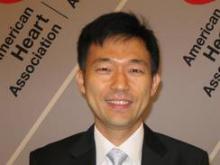Unclear-Onset Stroke Treated on Basis of MRI
FROM THE INTERNATIONAL STROKE CONFERENCE
LOS ANGELES – Neurologists may have moved one step closer to identifying patients with stroke of unclear onset who might benefit from treatment, a prospective multicenter study suggests.
About 25% of ischemic strokes occur in people who don’t know, or are unable to communicate, when their stroke began. Guidelines call for IV thrombolysis to be given within 4.5 hours of symptom onset, the effective treatment window for reducing disability, and patients with unclear-onset stroke traditionally have been excluded from thrombolytic therapy.
The study of 430 patients with unclear-onset stroke showed that basing treatment on MRI evaluation is feasible, with safety and efficacy similar to what was seen in pivotal trials of thrombolytic therapy, Dr. Dong-Wha Kang said Feb. 10 at the International Stroke Conference. The current study lacked a control group of comparable patients who did not receive therapy, however, making the true effect of treatment in these patients difficult to assess.
The 10 patients who were treated at two centers with little previous experience in thrombolysis for unclear-onset stroke were 11 times more likely to have poor clinical outcomes than were the patients treated at four centers where interventionists already had been selecting patients empirically for treatment of unclear-onset stroke. This difference in clinical outcomes "might be related to the expertise or the skill of the interventionists," Dr. Kang said at the meeting, sponsored by the American Heart Association.
He and his associates screened consecutive patients with unclear-onset stroke who presented at six university hospitals in South Korea within 6 hours of symptom detection. They used multimodal MRI to look for sizable areas with live brain tissue despite lack of blood flow, and to exclude patients from therapy who were at higher risk of serious bleeding from thrombolytic therapy or who were past the time of tissue death.
Patients qualified for reperfusion therapy if MRI findings showed the presence of greater than a 20% perfusion-diffusion mismatch, absence of extensive early infarct (with "extensive" defined as infarct in more than a third of middle cerebral artery territory) on diffusion-weighted imaging, and absence of well-developed parenchymal hyperintensity on fluid-attenuated inversion-recovery (FLAIR) imaging or T2 images.
A total of 83 patients (19% of the cohort) received reperfusion therapy, which included IV tissue plasminogen activator (tPA) with or without intra-arterial urokinase within 3 hours, or intra-arterial urokinase within 6 hours from symptom detection. (Urokinase is approved in Korea but not in the United States.) The study also allowed mechanical clot disruption or stenting. In all, 57 patients were treated using an endovascular approach (69%), 9 patients were treated with IV tPA only (11%), and both approaches were used in 17 patients (21%). (Percentages were rounded.)
In the 83 patients who underwent reperfusion therapy, 37 had a good clinical outcome (45%), defined as a score of 0-2 on the modified Rankin scale at 3-month follow-up, reported Dr. Kang of the University of Ulsan, Seoul, South Korea, and 24 patients (29%) had excellent clinical outcomes.
Eight patients developed symptomatic intracranial hemorrhage, five with neurological decline (6%) and three with at least a four-point increase in the National Institutes of Health Stroke Scale (NIHSS) score within 48 hours after treatment.
Poor clinical outcomes were nine times more likely in women than in men and 11% more likely in patients with higher baseline NIHSS scores. The treated patients had a mean age of 67 years and a median baseline NIHSS score of 14.
The investigators compared the clinical results with separate data from 156 similar patients whose stroke onset times were known. The percentage of patients who had good outcomes did not differ significantly between those groups, he said.
Dr. Kang received an award for the best paper in emergency medicine at the meeting.
The findings should be applicable to non-Korean populations, with variable patient outcomes depending on the availability of MRI and of interventionists to administer thrombolytic drugs, Dr. Kang said. Nine patients received treatment in violation of eligibility protocols, a review found. There were no significant differences in outcomes in patients treated per protocol or against protocol, but these are small groups of patients, he cautioned.
Dr. Kang and his associates next plan to compare their findings with data from stroke registries on comparable patients with unclear-onset stroke who were not treated.
The investigators reported having no relevant conflicts of interest.





